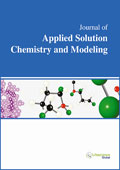jascm
Abstract : Vapor-Liquid Equilibrium at Several Experimental Conditions of the Binary Mixtures Methyl Lactate with n-Alkanols
 Vapor-Liquid Equilibrium at Several Experimental Conditions of the Binary Mixtures Methyl Lactate with n-Alkanols - Pages 14-20 Vapor-Liquid Equilibrium at Several Experimental Conditions of the Binary Mixtures Methyl Lactate with n-Alkanols - Pages 14-20Rubén Ezquerra, Alberto Latorre, Najla Ben Mahdoui and Carlos Lafuente DOI: https://doi.org/10.6000/1929-5030.2018.07.03 Published: 24 September 2018 |
Abstract: In this contribution the vapor-liquid equilibrium of the binary mixtures formed by methyl lactate and the first four lineal alkanols has been determined at constant pressure (p = 101.325 kPa) and at constant temperature (T = 323.15 K). The results have been adequately correlated with the Wilson equation. The obtained data have been satisfactorily checked for thermodynamic consistency using the van Ness method. Furthermore, we have applied the UNIFAC method to predict the vapor-liquid equilibrium and compared these predictions with the experimental results. |
Abstract : Ionic Liquids as Efficient Extractants for Quercetin from Red Onion (Allium cepa L.)
|
Abstract: The solubility of Quercetin in alcohols, esters and in 1-ethyl-3-methylimidazolium trifluoroacetate, [EMIM][TFA] ionic liquid (IL) using the dynamic method was measured at constant pH in a range of temperature 233-373 K and compare to the literature data. The experimental solubility data have been correlated by means of commonly known GE models,UNIQUAC and NRTL with the assumption that the systems studied here present simple eutectic behaviour. The basic thermal properties of Quercetin, i.e., fusion temperature and the enthalpy of fusion have been measured with differential scanning microcalorimetry technique (DSC).The application of alcohols, esters and ionic liquids (ILs) as alternatives to conventional organic solvents in the liquid-liquid extraction of Quercetin from different medicinal plants, flowers and frozen red onion (Allium cepa L.) was investigated. The parameters affecting the extraction yield using ILs such as chemical structures of the IL cation and anion, the phase volume ratio of extracting solvent, time of extraction and the Quercetin form of sample and concentration were evaluated. Specific Quercetin composition was performed through HPLC measurements. Using the most effective ILs in extraction, the 14.3±0.1g∙kg-1 and 5.9±0.1 g∙kg-1of Quercetin from frozen pure red onion was obtained with N,N-diethyl-N-methyl-N-(2-methoxyethyl)ammonium tetrafluoroborate, [N2,2,1,2OCH3][BF4] and 1-ethyl-3-methylimidazolium trifluoroacetate, [EMIM][TFA], respectively. |
Abstract : A New Model for the Full Inclusion of Precipitation Reactions in the General Ionic Equilibrium Framework of Homogeneous Solutions Based on the Fraction of Species Concept in Heterogeneous Systems
 A New Model for the Full Inclusion of Precipitation Reactions in the General Ionic Equilibrium Framework of Homogeneous Solutions Based on the Fraction of Species Concept in Heterogeneous Systems - Pages 39-51 A New Model for the Full Inclusion of Precipitation Reactions in the General Ionic Equilibrium Framework of Homogeneous Solutions Based on the Fraction of Species Concept in Heterogeneous Systems - Pages 39-51Eduardo Rodríguez de San Miguel DOI: https://doi.org/10.6000/1929-5030.2018.07.05 Published: 13 December 2018 |
Abstract: This study aims at extending the general methodology for the study of predominance and reactivity of ionic homogeneous solutions to precipitation reactions. This extension was satisfactorily formulated by the definition of the fraction of species concept in heterogeneous systems for the first time. An easy form to fully integrate the ion product concept with other descriptions of homogeneous ionic reactions, to obtain predominance zone diagrams (PDZ), to enrich the use logarithmic relative diagrams, to generate continuous equations from titration curves, and to generalize side-reaction coefficients to heterogeneous systems using easy-to-compute algorithms of calculation is shown. |
Abstract : Influence of Low-Frequency Sonolysis on the Kinetics of Liquid-Phase Chemical Reactions Involving Associates
 Influence of Low-Frequency Sonolysis on the Kinetics of Liquid-Phase Chemical Reactions Involving Associates - Pages 52-54 Influence of Low-Frequency Sonolysis on the Kinetics of Liquid-Phase Chemical Reactions Involving Associates - Pages 52-54Tatiana P. Kulagina, Lev P. Smirnov and Zoya S. Andrianova DOI: https://doi.org/10.6000/1929-5030.2018.07.06 Published: 14 December 2018 |
Abstract: The influence of low-frequency sonolysis on the kinetics of liquid-phase bimolecular liquid-phase reactions was studied by mathematical modeling with due regard for the association of starting reagents into dimers and trimers. With increasing frequency and amplitude of low-frequency sonic waves (up to some critical value), we observed the disappearance of trimers and concomitant cessation of the reaction. This observation offers an additional tool for controlling reaction rate by the external action of low-frequency vibrations. |





















